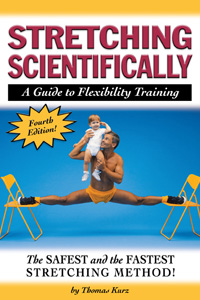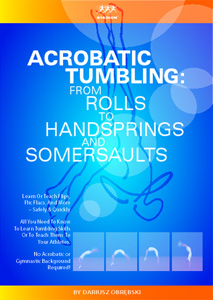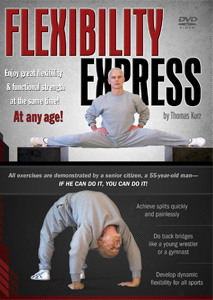by Thomas Kurz
While in some sports more than average flexibility in all or some of the major joints is needed just for the execution of their basic techniques, in some others the reverse is true: The greater than average the flexibility of some joints, the worse the performance. For example, running economy has been associated with decreased flexibility. Stiffness of the calf muscles and Achilles tendon enhances “elastic energy storage and return” during every running step, and the small range of motion of external rotation in the hip reduces the metabolic cost of the muscular activity needed for stabilizing the pelvis during long-distance running (Craib et al. 1996). So, for long-distance runners, the greater the dorsiflexion of the foot and external rotation in the hip joint, the worse the running economy.
Even in sports that most people imagine require maximal flexibility, an athlete can have too much of it. Female gymnasts with symptoms of musculoskeletal disorders of the lower back can touch the floor behind their feet (when leaning forward in a standing position) farther than those without symptoms (Kirby et al. 1981). This may be caused by having weak or overstretched (inhibited by excessive stretching) hamstrings or muscles of the buttocks (Walther 2000).
In sports that stress overhead or above-shoulder arm movements, such as baseball pitching, javelin throwing, racket sports, butterfly or freestyle swimming, and Olympic-style weightlifting, athletes spend considerable time on stretching their shoulders. This stretching has to be done intelligently—not just pushing and pulling for the maximal possible range of motion. Forced stretching of the shoulder—past the point where you can move using the stretched muscles—can damage the capsule of the shoulder joint, leading to shoulder instability and pain (McMaster and Troup 1993; McMaster et al. 1998). This principle of not stretching past the point where you can move using the stretched muscles holds true for all joints, not just the shoulder.
In some techniques, above-average flexibility may pose problems other than increasing the likelihood of injury or making movements less economical. Coach Dariusz Obrebski, author of Acrobatic Tumbling, points out that while “in the aerial cartwheel and in the front handspring greater overall flexibility will help, in the back handspring, however, a great flexibility of the spine may cause one to perform it by bridging backward more than by jumping.” This robs the back handspring of its dynamic drive backward, which can be converted to increasingly higher and faster techniques for an impressive tumbling run. After the less dynamic back handspring, done more by bridging backward than by jumping, there is not enough momentum to bounce into a high somersault, for example. The error of bridging or bending back into a back handspring happens to some very flexible female gymnasts and can be very difficult to correct.
Coach Obrebski further notes: “Generally, in gymnastics and acrobatics [just like in all sports involving jumping—TK], an overly flexible body weakens takeoffs and rebounds because these elements benefit from high stiffness of the body. This is why acrobats have to work both on flexibility and on strength. Having the adequate range of motion, with stability and explosiveness, makes it easier to perform acrobatic techniques.”
Adequate flexibility or range of motion is such flexibility, which permits performing one’s techniques in the most efficient body alignment and without wasting energy on overcoming tightness of muscles and ligaments.
Excessive flexibility is such that one needs to exert an extra effort to maintain stability of one’s joints or even cannot actively stabilize one’s joints at near maximal range of motion.
The best and most time-efficient exercises to prevent imbalances between flexibility and strength are those that increase flexibility and strength simultaneously. Teaching such exercises is the purpose of Flexibility Express DVD.
For full references quoted in this article, see my book Stretching Scientifically.
This article is based on the book Stretching Scientifically: A Guide to Flexibility Training and on the DVD Acrobatic Tumbling: From Rolls to Handsprings and Somersaults. Get them now and have all of the info—not just the crumbs! Order now!
Flexibility Express delivers simultaneous gains in strength and flexibility of the entire body for athletes in all sports.
If you have any questions on training you can post them at Stadion’s Sports and Martial Arts Training Discussion Forum



